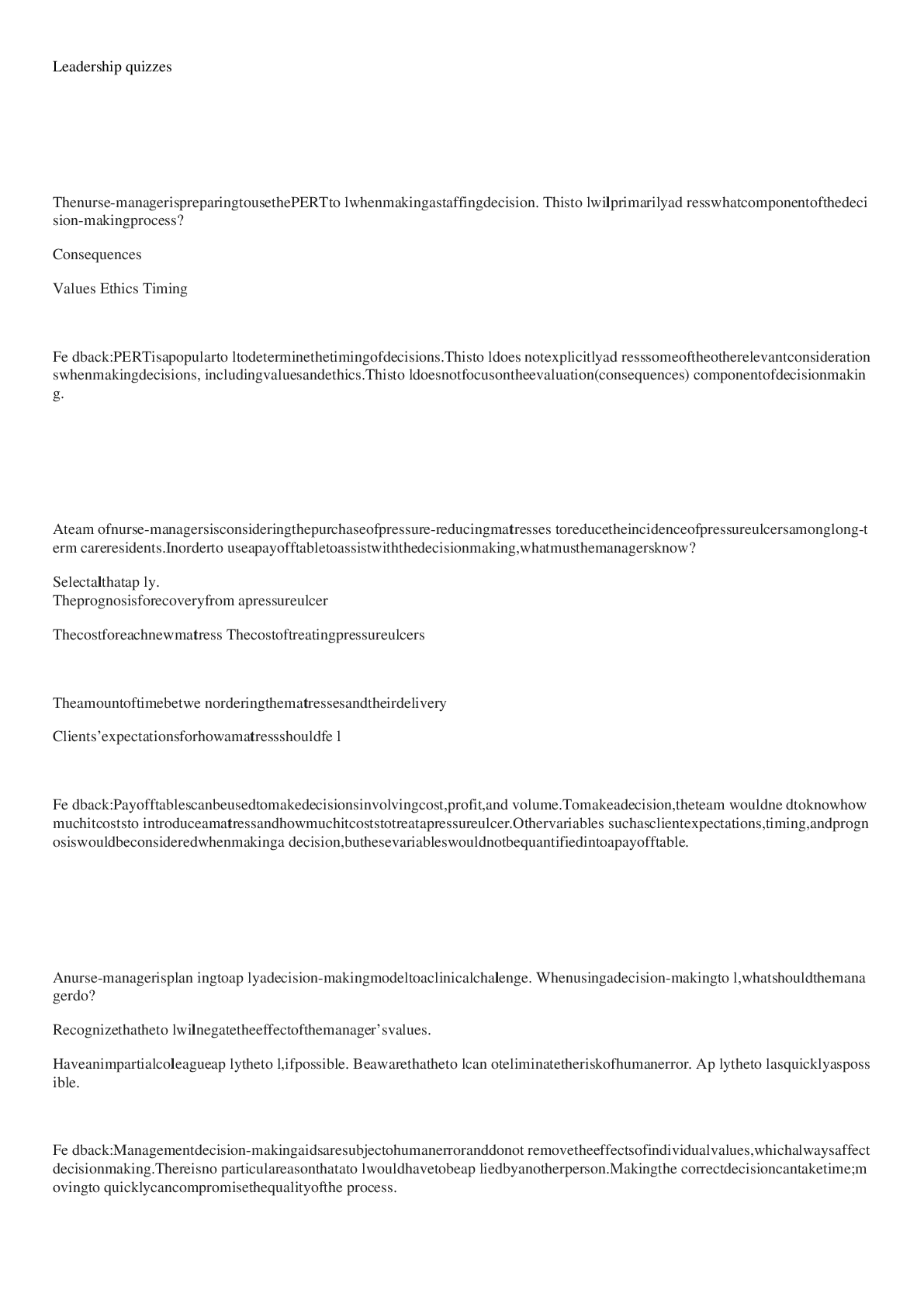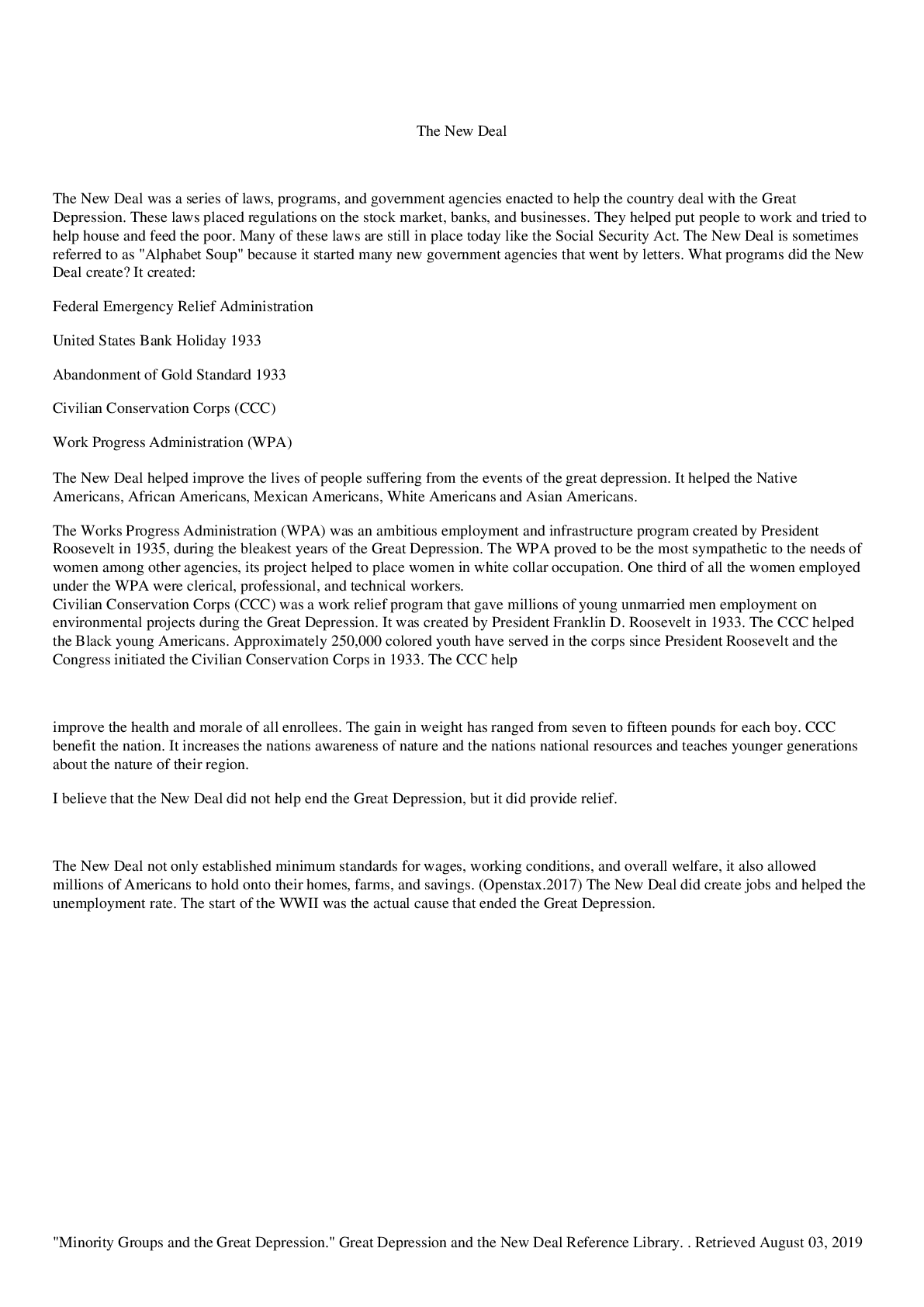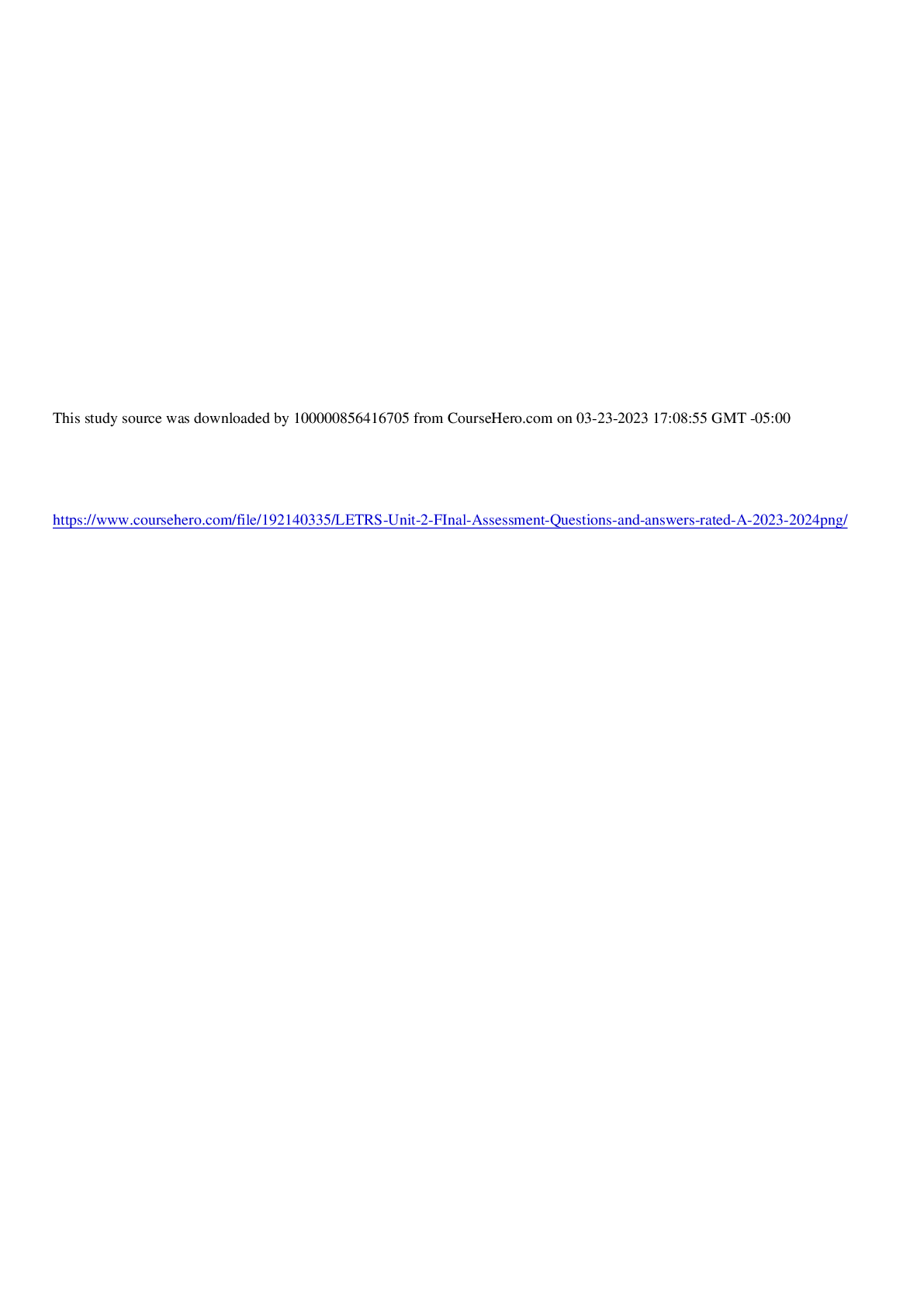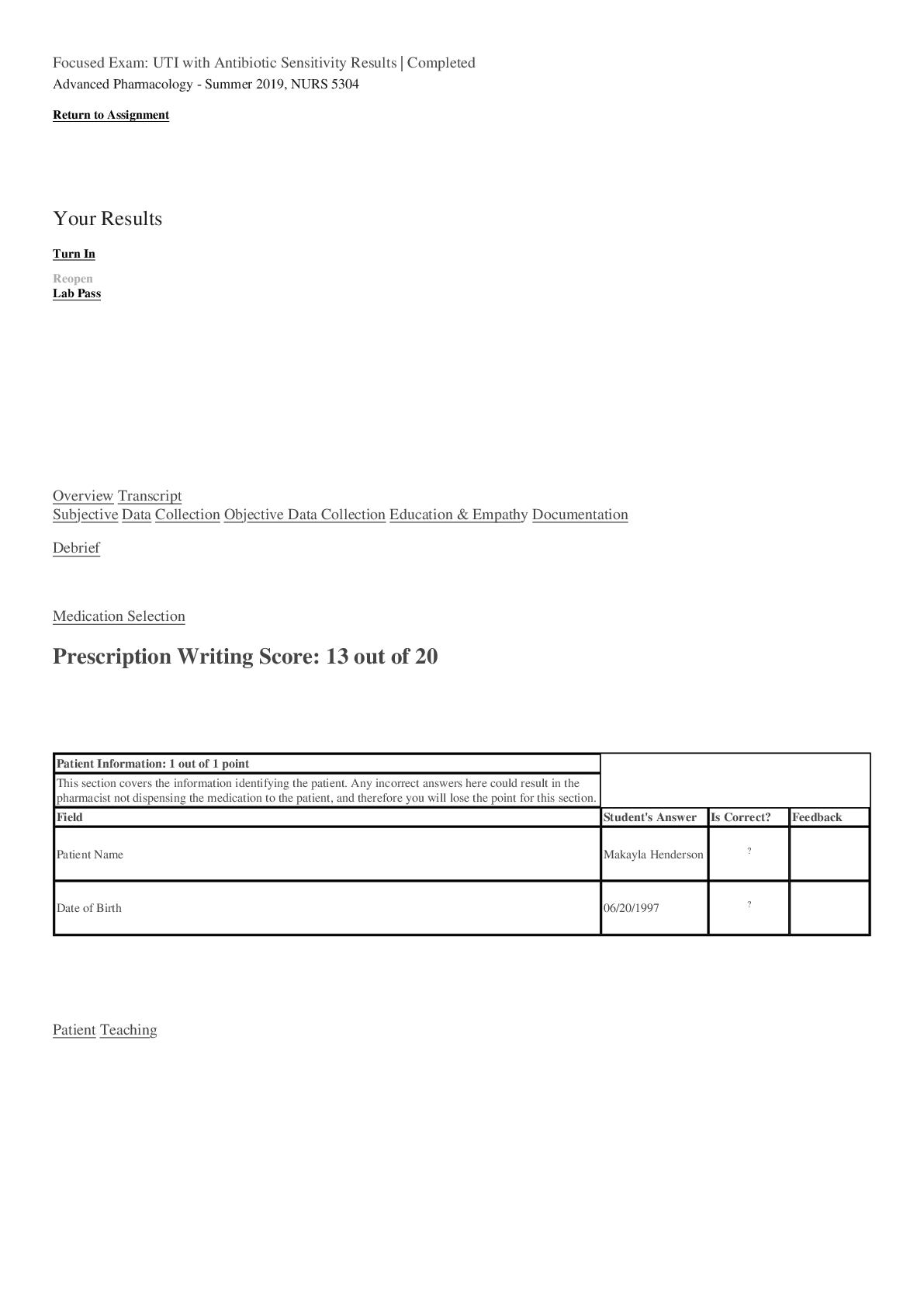Leadership > QUESTIONS and ANSWERS > Western Governors University LEADERSHIP 21: Leadership quizzes Answered with feedbacks 2023 updated (All)
Western Governors University LEADERSHIP 21: Leadership quizzes Answered with feedbacks 2023 updated
Document Content and Description Below
Leadership quizzes Question 1 10 / 10 pts The nurse-manager is preparing to use the PERT tool when making a staffing decision. This tool will primarily address what component of the decision-making pr... ocess? Consequences Values Ethics Timing Feedback: PERT is a popular tool to determine the timing of decisions. This tool does not explicitly address some of the other relevant considerations when making decisions, including values and ethics. This tool does not focus on the evaluation (consequences) component of decision making. Question 2 10 / 10 pts A team of nurse-managers is considering the purchase of pressure-reducing mattresses to reduce the incidence of pressure ulcers among long-term care residents. In order to use a payoff table to assist with the decision making, what must the managers know? Select all that apply. The prognosis for recovery from a pressure ulcer The cost for each new mattress The cost of treating pressure ulcersThe amount of time between ordering the mattresses and their delivery Clients’ expectations for how a mattress should feel Feedback: Payoff tables can be used to make decisions involving cost, profit, and volume. To make a decision, the team would need to know how much it costs to introduce a mattress and how much it costs to treat a pressure ulcer. Other variables such as client expectations, timing, and prognosis would be considered when making a decision, but these variables would not be quantified into a payoff table. Question 3 10 / 10 pts A nurse-manager is planning to apply a decision-making model to a clinical challenge. When using a decision-making tool, what should the manager do? Recognize that the tool will negate the effect of the manager’s values. Have an impartial colleague apply the tool, if possible. Be aware that the tool cannot eliminate the risk of human error. Apply the tool as quickly as possible. Feedback: Management decision-making aids are subject to human error and do not remove the effects of individual values, which always affect decision making. There is no particular reason that a tool would have to be applied by another person. Making the correct decision can take time; moving too quickly can compromise the quality of the process. Question 4 10 / 10 pts What action by the nurse-manager in a health organization best demonstrates transformational leadership?The manager’s employees are reminded that they must submit evidence of renewing their license. The manager holds a workshop to outline a new vision for patient-centered care. The manager readily takes responsibility after making a scheduling error. The manager informs each employee about the new criteria that will be the basis of the performance reviews. Feedback: Transformational leadership often involves the communication of a vision and empowering employees to share in it. Functions involving performance review, scheduling, and licensure are more consistent with a transactional role. Taking responsibility is a trait of effective transformational and transactional leadership. Question 5 10 / 10 pts The nurse-manager of the perioperative department is attempting to apply the full-range leadership model (FRLM) when overseeing the department. The nurse should attempt to integrate what types of leadership? Select all that apply. Scientific Laissez-faire Transactional Autocratic TransformationalFeedback: The FRLM integrates the principles of laissez-faire, transactional, and transformational leadership. This model does not emphasize practices associated with autocratic leadership. Scientific management is an antiquated model of management that was influential in the early 20th century, not in contemporary models of leadership such as FRLM. Question 6 10 / 10 pts A nurse oversees the care on a hospital unit in the role of an integrated leader-manager. What characteristics should this nurse exhibit? Select all that apply. The nurse has influence that goes beyond her own group. The nurse describes herself has an “inward thinker.” The nurse’s thinking includes long-term issues. The nurse is always conscious of political realities. The nurse consciously attempts to motivate the employees. Feedback: Gardner asserted that integrated leader-managers possess six distinguishing traits: They influence others beyond their own group; they emphasize vision, values, and motivation; they think longer term; they look outward, toward the larger organization; they are politically astute; and they think in terms of change and renewal. Question 7 10 / 10 pts To decrease overtime, the manager of a surgical unit offers nurses who get their work finished on time for an entire 2-month period an extra day off with pay at regular time. The nurse is enacting what model of leadership? Principal agent theoryServant leadership Favoritism Quantum leadership Feedback: Principal agent theory suggests that followers may have an informational (expertise or knowledge) advantage over the leader as well as their own preferences, which may deviate from that of the principal. This may lead to a misalignment of goals. To influence the agent, the principal offers an incentive that corrects excessive overtime. This action is performance-based, so it would be difficult to characterize it as favoritism. Servant leadership prioritizes the interests of others; creating incentives to address the misalignment of goals is not central to servant leadership. Quantum leadership is a holistic theory of leadership that does not mainly focus on the alignment of disparate goals. Question 8 10 / 10 pts A nurse-manager has proposed a change in the skills mix on a hospital unit, with fewer registered nurses and more nursing assistants. What outcome best demonstrates that the nurse is applying the principles of thought leadership? Nurses and nursing assistants will both participate in the operations planning. Skeptics of the plan have begun to see it as innovative and beneficial. The ultimate decision on the matter will be based on rational ideas rather than emotions. Individuals who oppose the plan have become isolated by their peers.Feedback: Thought leadership refers to any situation in which one individual convinces another to consider a new idea, product, or way of looking at things. The theory does not advocate achieving this through ostracizing dissenters. Inclusive leadership groups are beneficial, but this is not a particular characteristic of thought leadership. Thought leadership does not imply a rejection of emotion. Question 9 10 / 10 pts The nurse-manager has learned there is conflict between a nonresponsive client’s family members about the best plan of care. The manager recognizes the complex ethics of this situation. What is the manager’s best action? Base a decision on the most recent precedent in the organization. Ask an impartial staff member to mediate. Refer the family to the hospital’s spiritual care service. Make contact with the hospital’s ethics committee. Feedback: An ethics committee can bring needed experience, perspective, and insight to challenging ethical situations. Precedent cannot always be used as a guide because each situation is unique even if they appear superficially similar. Clients and families often benefit from spiritual care, but this does not help the manager make a good decision. Mediation can sometimes be beneficial, but this does not release the nursemanager from addressing the situation as best as he or she can. Question 10 10 / 10 pts The new nurse-manager has committed to modeling the leadership roles associated with applying ethics in the workplace. What is the manager’s best action? Ensure nurses are responsible for scrutinizing each other’s behavior to monitor for ethical violations.Ensure that individual rights are always prioritized over collective rights. Delegate ethical decision making to staff nurses whenever possible. Demonstrate self-awareness about his or her own beliefs, morals, and values. Feedback: A core competency for ethical leadership is evaluating one’s own values and beliefs. This form of self-reflection is foundational for providing ethical care and promoting in others. The balance between individual and collective rights is situationspecific; individual rights are not always priorities over group interests. The manager must show leadership in ethical decision making and cannot always delegate this important function to staff. Ethical nurses are observant for violations, but this should not result in an environment where each nurse is “scrutinizing” colleagues’ practice. Quiz #2 5-9 Question 1 10 / 10 pts What is the best reason that nurse-managers have an ongoing responsibility to be aware of legislation affecting nursing practice? Awareness is included in nursing standards of practice. Laws are created by people who are not nurses. Awareness will help ensure ethical practice. Laws are fluid and subject to change. Feedback: When using doctrines as a guide for nursing practice, the nurse must remember that all laws are fluid and subject to change. Laws are not static. It is the responsibility of each manager to keep abreast of legislation and laws affecting both nursing practice and management practice. It is true that laws are made by people whoare not nurses, but this does not necessarily create a need for managers to stay abreast of laws. Standards of practice do not explicitly guide nurses to remain aware of changes in legislation. Awareness is unlikely to have a direct effect on ethical practice, which is rooted in values and beliefs about what is good. Question 2 10 / 10 pts The nurse-manager oversees the care of several dozen nurses. With which nurse should the manager review the provisions of the Health Insurance Portability and Accountability Act (HIPAA)? A nurse who completed a client’s documentation outside of the client’s room A nurse who has initiated contact with the social worker to discuss a client’s discharge planning A nurse who has discussed a client’s status with a physician over the telephone A nurse who confirmed a new client’s admission to the unit to a relative who telephoned Feedback: HIPAA states that a client’s privacy and confidentiality must be maintained. Confirming a new client’s presence on a unit can be problematic because the identity of the person speaking cannot be confirmed. Communicating by telephone with other members of the care team is acceptable, provided efforts are taken to protect the client’s privacy from others who may overhear. Documentation can be completed in any setting, provided it is guarded from view of unauthorized persons. There is no prohibition against initiating contact for referrals. PartialQuestion 3 7.5 / 10 pts The nurse-manager can implement workplace advocacy and subordinate advocacy by performing what actions? Select all that apply. Including nurses in the decisions that must be made at the facilityCreating an atmosphere that is free of violence or the threat of violence Encouraging clients to provide feedback about the care they provide when they are discharged Making efforts to ensure that nurses have reasonable and predictable work schedules Providing education about injury prevention and safety Question 4 10 / 10 pts A nurse-manager has been asked to write an article for the newspaper addressing a health-care issue of local concern. Which statement demonstrates the nurse’s understandings of the appropriate way to respond to such a request? Select all that apply. “Working with the media is outside my scope of practice, but I’ll recommend you to someone else.” “That isn’t my field of expertise but I will contact a peer with that knowledge.” “When will you need to have the final draft of my article?” “Are you comfortable with me focusing on three key points related to this topic?” “I’ll include the latest data on the subject.” Feedback: Tips for effective interaction with the media include respecting and meeting their deadlines, having key facts ready to include, limiting key points to two or three, andnot being afraid to say you lack that specific expertise. Working with the media is not something that is beyond the nursing scope or practice. Question 5 10 / 10 pts A nurse is participating in the process of values clarification. What are the characteristics of a true value? Select all that apply. It aligns with the dominant values of society. It is acted upon. It is positively affirmed. It is freely chosen from among alternatives. It is prized and cherished. Feedback: McNally identified the fact that a value is prized and cherished, positively affirmed and acted on, and chosen freely from among alternatives. It is possible for a value to be true while not aligning with the dominant values of the society. Question 6 10 / 10 pts Which statements concerning the role of the leader-manager in organizational planning are true? Select all that apply. The leader-manager must be the most experienced clinician in the organization. The leader-manager must be future-oriented.The leader-manager must evaluate the social climate that affects the organization. The leader-manager should possess human resource management skills. The leader-manager has to be willing to take risks. Feedback: Planning requires managerial expertise in health-care economics, human resource management, political and legislative issues affecting health care, and planning theory. Planning also requires the leadership skills of being sensitive to the environment, being able to appraise accurately the social and political climate, and being willing to take risks. A leader-manager can give effective oversight without being the most experienced clinician on the unit. Question 7 10 / 10 pts The nurse who provides oversight to a large health-care organization can best demonstrate leadership during a time of change by: acknowledging that there is going to be resistance during the change process. asking permission of nurses before proposing a change process. communicating a vision that change is an opportunity to be embraced. clearly and assertively reminding nurses of their responsibilities to accept change. Feedback: The leader should be open and receptive to change and views change as a challenge and an opportunity for growth. A focus on responsibilities may create a backlash and increase resistance. Collaboration is necessary, but this is not synonymous with asking permission for change. Resistance should be expected, but stating this fact does not demonstrate leadership. Question 810 / 10 pts The nurse-manager is describing the forces that are driving change in today’s healthcare environment. What phenomena should the nurse describe? Select all that apply. Decreased use of technology due to high cost of implementation Shortages of health-care professionals and providers Decreased third-party reimbursement for health-care services Increased need to update health-care–related technologies Increased cost of health-care services Feedback: Many forces are driving change in contemporary health care, including rising health-care costs, declining reimbursement, workforce shortages, increasing technology, the dynamic nature of knowledge, and a growing elderly population. Even though technology is expensive, its use is increasing. PartialQuestion 9 6.67 / 10 pts Which statements demonstrate adherence to habits that supports good personal time management skills? Select all that apply. “I’ve learned that I’m most energetic in the morning.” “I’m learning to trust the members of my team.” “I’ll adjust my sleep schedule now that I’m on night shift.”“I never quit a task that I’ve decided to do.” “It’s important to me to be professional.” Question 10 10 / 10 pts A novice nurse-manager is frequently late for appointments. This manager’s colleagues are likely to have what perception of the manager? The manager does not value other people’s time. The manager is overworked with too many responsibilities. The manager lacks the skill necessary for the job. The manager needs additional management training. Feedback: A lack of punctuality suggests that one does not value other people’s time. Chronic lateness is likely to cause resentment among colleagues, not a recognition of the manager’s needs for more support. 2nd try Question 1 10 / 10 pts Which statement best describes the impact that the concept of respondeat superior has on the issue of nursing liability? It supports the sharing of blame among all involved sources of health-care services. It encourages legal intervention when health care is thought to be substandard.It allows for equal liability among physicians, nurses, and health-care organizations. It implies that the institution is responsible for errors, not the employee. Feedback: Nurses must remember that the purpose of respondeat superior is not to shift the burden of blame from the employee to the organization but rather to share the blame, increasing the possibility of larger financial compensation to the injured party. Liability is not always apportioned equally in every situation, and it does not wholly release employees from liability. Question 2 10 / 10 pts A client is preparing to be discharged from the health-care facility and has told the nurse that he would like to read his medical record. What is the nurse’s best initial action? Confirm the facility’s policy around providing medical records to clients. Check whether this provision is included in the jurisdiction’s Nurse Practice Act. Inform the client that this request will be communicated to the facility’s ethics committee. Arrange for the medical record to be provided to the client. Feedback: Clients possess a right to view their medical records, but the protocols for facilitating this vary. Consequently, the nurse should check this facility’s policy before acting. It would likely be premature for the nurse to provide the medical record to the client before communicating with other members of the care team or administrators to ensure policy is followed. This matter is outside the purview of ethics committees because it does not involve a dilemma. The Nurse Practice Act focuses on scope of practice and other regulatory issues, not client rights. IncorrectQuestion 30 / 10 pts Which strategy best demonstrates an understanding of the managers role as an advocate for his or her subordinates? Working with primary care providers to expand standing nursing orders Posting a copy of the code of ethics in the staff room Addressing an employee’s high rate of absenteeism Establishing friendships with as many of the nurses as possible Feedback: Promoting nurse autonomy in the form of increased standing orders is an example of advocating for subordinates. Publicizing the code of ethics may be beneficial for nurses but does not advocate on their behalf. In the same way, a manager is being responsible by addressing absenteeism, but this is unlikely to entail an advocacy role. The manager should seek professional relationships, not friendships. Question 4 10 / 10 pts A nurse is involved in a challenging clinical situation which requires the nurse to consider many people’s interests. How can the nurse best implement Standard VII of the American Nurses Association (ANA) Scope and Standards of Practice? Seek legal advice promptly. Carefully consider the ethical aspects of the situation. Advocate for the organization’s interests above those of individuals. Allow the client to read the documentation about the situation.Feedback: Standard VII of the American Nurses Association (ANA) Scope and Standards of Practice (2015) states that the registered nurse practices ethically. Consequently, this standard is more closely related to issues around ethics than issues around documentation or legality. It is simplistic and inaccurate to presume that the organization’s interests always supersede the individual’s interests. Question 5 10 / 10 pts An organization is considering a revision to its philosophy. What characteristic of the current philosophy would most clearly indicate a need for revision? The philosophy was created after the organization’s vision and mission were determined. Staff claim the stated unit philosophy is in contrast to the care that is being given. The philosophy is more than 5 years old. The philosophy was appropriated from a different health-care facility. Feedback: An organizational philosophy that is not or cannot be implemented is useless. An old philosophy is not necessarily obsolete, and it is possible to adopt a philosophy from another facility if it is appropriate in a different setting. It is acceptable for an organization’s philosophy to flow from the vision and mission statements. Question 6 10 / 10 pts Which statement best describes an emerging paradigm that is likely to influence strategic planning for health care in the 21st century? Reduced emphasis on cost containment Reduced regulatory oversight of health-care organizationsContinued increases in the cost of pharmaceuticals A shift from interdependence of health-care professionals to greater autonomy Feedback: The rising cost of pharmaceuticals and ongoing drug shortages will continue to be a problem for US hospitals for at least the next 3 years. Cost containment, regulatory oversight, and interdependence of health-care providers are predicted to continue. Question 7 10 / 10 pts A planned change has been imposed by upper management at a large hospital and will greatly affect the delivery of care on inpatient units. What is an appropriate role for the leader-manager in this time of change? Implementing the change as rapidly as possible Mobilizing resistance in a respectful but assertive way Dialoguing with staff about the benefits of maintaining the status quo Demonstrating a positive attitude toward the prospect of change Feedback: Even when a change process has not been collaborative, the leadermanager still has a responsibility to demonstrate a positive outlook on change. Mobilizing resistance would be a subversive act that would be reserved for only the most harmful of proposed changes. Rapid change can sometimes cause chaos rather than efficiency. Dialoguing with staff about keeping the status quo would have the effect of increasing resistance. Question 8 10 / 10 ptsA nurse-manager has introduced a proposed change to the operations of an ambulatory clinic and has been met with resistance. How should the manager best interpret this resistance? The presence of resistance indicates a need to implement power–coercive strategies. Resistance confirms that the proposed change is necessary. The presence of resistance suggests that the change may be unsuccessful. Resistance is an expected component of a proposed change. Feedback: Resistance is an expected component of a change process and it does not suggest that change will be unsuccessful. However, the presence of resistance does not necessarily validate that the change was necessary. A manager should interpret the presence of resistance as indicated a need to implement power–coercive change strategies. Question 9 10 / 10 pts The nurse-manager is frustrated by the quantity of paper clutter. How should the manager best deal with this time waster? Set aside a block of time once per week to process documents. Place additional recycling and trash receptacles throughout the unit. Deal with paper correspondence as soon as possible after it arrives. Require face-to-face communication between staff members rather than written documentation.Feedback: Whenever possible, incoming correspondence should be handled the day it arrives. It should either be thrown away or filed according to the date to be completed. Letting it accumulate for a week at a time may make the problem worse, not better. Many forms of written documentation cannot be replaced by face-to-face conversation. Providing more waste receptacles will not help the manager process paperwork, which cannot normally be discarded without being addressed. Question 10 10 / 10 pts A nurse-manager makes lists of tasks for each day. What should the manager do in order to ensure that lists accurately reflect changes in priorities? Ensure that each day’s list is significantly different from the previous day’s list. Make lists as detailed as possible in terms of the time allocated and the specifics of each task. Have the lists reviewed by a trusted colleague on a regular basis. Reevaluate the lists on a regular basis and adjust them as needed. Feedback: Evaluating and reprioritizing are vital aspects of time management. There is no obvious benefit in aiming to make lists different from other days’ lists. Increased detail can help with time management, but this does not help the manager adjust time and tasks as needed. Similarly, review by a colleague does not mean that the manager’s planning will respond to short-term changes. [Show More]
Last updated: 1 year ago
Preview 1 out of 10 pages
Instant download

Buy this document to get the full access instantly
Instant Download Access after purchase
Add to cartInstant download
Reviews( 0 )
Document information
Connected school, study & course
About the document
Uploaded On
Feb 20, 2023
Number of pages
10
Written in
Additional information
This document has been written for:
Uploaded
Feb 20, 2023
Downloads
0
Views
55




.png)



.png)



